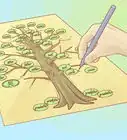This article was co-authored by wikiHow Staff. Our trained team of editors and researchers validate articles for accuracy and comprehensiveness. wikiHow's Content Management Team carefully monitors the work from our editorial staff to ensure that each article is backed by trusted research and meets our high quality standards.
There are 9 references cited in this article, which can be found at the bottom of the page.
This article has been viewed 44,667 times.
Learn more...
For people who want to learn more about their family or another's family history, a family tree can be of great help. Creating one of these documents can be important for a variety of reasons. Including everything from DNA or family medical history research to cultural appreciation. A family tree also allows you to pass on knowledge through generations. Some basic steps can help make the process of how to start a family tree much easier.
Steps
Gathering Your Resources
-
1Compile information you already know about your family. Start gathering information by compiling all the relevant information you have access to. Additionally, talk to any living family members. [1]
- Ask your relatives about your family history. Don't just try to get facts. Instead, ask for memories and stories. Having a conversation with a family member can actually yield better information than just trying to figure out who was where at a certain time.
- Go through your family's storage and look through photo albums, family records like birth certificates, letters, diaries, and even newspaper clippings.
- You can also email your distant relatives and ask for access to any information your relatives may have.
- Gather everything that you think might help you. If a photo has a date or other information written on the back, this could be a useful clue.
-
2Find records from various sources. Online ancestry and family history services can often provide much of what you need to start filling in a family tree.
- You can also get historical records from companies serving some of the world's historic immigration sites. For instance, in the United States, an Ellis Island program offers free searches of historical records. More in-depth information is available for a small fee. [2] Other sites like Ancestry.com offer comprehensive family tree building services as well. [3]
- Sort records by type. You will be looking for various historical records in order to add more information to a family tree. Look for birth or death certificates, marriage certificates, baptismal records and other items simultaneously. Think about how each type of public record will aid in your research. It's best to keep your records sorted and organized in some method that works for you. You may like having separate folders for each type.
Advertisement -
3Locate family memoirs and heirlooms. In many families, those who have come before you have recorded specific important heritage and ancestry information.
- In some cases, an heirloom is in the form of a printed book or a memoir that includes genealogy data. Other times, families record genealogy in a family Bible or other book or document. These resources will help you get a better start for your own historic record.
-
4Use national historic resources. Many countries offer national archives and other resources for helping families develop personal genealogies.
- Look at public records which can help you in your search for critical information on your heritage.
- If you're in the U.S., searching the U.S. census data can be a helpful resource. [4]
- You can find public records at your local library or courthouse. You can also look through military records if you had family members who have been in the service.
-
5Choose a reference point. For the most coherent family tree, you'll want all of your research to boil down to a specific person as a reference point.
- Your reference point is an individual in your family that marks the beginning of the family tree structure. This can be yourself, one of your children, or anyone else in your family.
- In most cases, starting with yourself is the most efficient and easiest method.
-
6Organize all your information. Gather all of the information you have found and begin to organize it so that you can easily find what you need.
- How you organize your information is up to you. You may want to organize all documents by generation, person, or side of your family after branching off from your reference point.
- You may want to even create a spreadsheet that lists all your family members so far. In columns next to the name you can add relevant information. Include information like geography, years alive, birthdate and death date, etc. If you have a lot of physical items like photos and other documents, you should notate where you can reference these documents in the spreadsheet.
Beginning Your Family Tree
-
1Select a format. When you have all of your sources together, you'll want to look at how to best present your family tree.
- Some “vertical" or "standard" options feature the familiar chart-type designs you see in printed family tree documents. Other styles like an hourglass, bow-tie or fan format make a family tree document look different. The format you use will depend on how far back you wish to go and what kind of information you want to include. [5]
- When starting your family tree, you may find that it's easiest to start with a simple five generation format. [6] Many five generation family tree structures are great for starting out as you'll have room to add some vital information. You'll also be able to go fairly deep into your history. At the same time, after five generations, you may have a much harder time finding information.
- You can also find helpful templates for families that aren't “traditional”. There are options for blended families, single parent trees, adoptive family trees, etc. [7]
-
2Decide on a print or electronic version. In some cases, a nicely printed family tree is a better reference point than an online document. However, if you need to send this information to many people, you may want to choose an electronic option.
- Making a detailed tree by using a website or software like Excel allows you the freedom to easily make notations and changes.
- Using a printed version will allow you to make a very nice looking family tree on nice paper. You can even add some art to your family tree.
- If you're just starting out, making an electronic tree might prove to be easier and more efficient. Then, once you have completed it, you can recreate it on paper.
-
3Start with yourself. In most cases, starting with yourself as the reference point is the best method. But even if you didn't, you should still begin actually populating your family tree with yourself. [8]
- If you have children, you can place your children behind you on the chart. Then moving out and away from you.
- Family trees can branch out in many different ways. Which is why starting with yourself as the anchor will help you stay organized. Whether you go from the bottom up, top to bottom, or horizontally, the first box should contain your information.
-
4Create a draft. Many of those who have experience in making a family tree recommend starting with a rough draft of what you know.
- In whatever format you've chosen, a rough draft will help you determine how much information you can fit. Having a basic structure in place can also help you find more of the missing pieces in your genealogy and organize your family tree.
- Your draft will inform you of how complex your current format can be. If you want to include more details than you have space for, you may need to restructure your family tree's format.
- In your draft, start to create a legend to reference. For example, brackets going from one box to two boxes typically indicate the parents of the previous box. Note this method for connecting family members somewhere in your tree.
- Also make sure that you are using birth names in your draft. For example, if your mom took your dad's last name when the two married, don't use your last name. Use your mom's maiden name.
Continuing to Build Your Family Tree
-
1Continue to fill out your tree. Populate your tree with all of the current information you have compiled.
- As you fill out and populate your family tree make note of what resources you are using.
- When you have populated your tree, go over all your resources and see if you missed something. Then, you may want to locate all the information, pictures, files, etc. you didn't use. Separate the unnecessary information from the necessary information.
-
2Create a chart for the gaps in your tree. You can do this in a chart you've already created or make a new one if it's easier. But you should now make note of what information you are still missing.
- Check to see if you have all the information you want for each family member. Are you missing birthdates, marriages, or any other relevant information?
- Make detailed notes of what you still need. Perhaps you couldn't find any information on who your great-grandmother married. Or, you still don't know when your grandfather came to your country.
-
3Search for different variations of surnames. Start searching again, this time being more specific as you know what information you need. Try searching through records using different names or dates.
- Depending on when a certain family member moved to a new country, these members may have had a different name. Alternatively, you may eventually discover that the dates you thought were correct were actually wrong.
- Ask your family if anyone had a different name or a variation of a name. Search Google and other records with different parameters. You can set date ranges when searching on Google to filter out any dates you don't want results from.
-
4Continue adding information as you find it. Now that you've started your family tree you can continue to expand it and fill in all the blanks as you discover more.
- When you find new information, add it to your tree and notate where you found the information.
- You can continue building out a record of your genealogy going as far back as you wish.
Community Q&A
-
QuestionWho will at the top of the family tree?
 Community AnswerThe top of the family tree is reached when you can find no more research. Basically, the top of the family tree is the last person you can gather research for.
Community AnswerThe top of the family tree is reached when you can find no more research. Basically, the top of the family tree is the last person you can gather research for. -
QuestionHow do you find where your family tree really started?
 Community AnswerTime and research and luck. You have to do an awful lot of tracing backwards, as humanity has been around for centuries.
Community AnswerTime and research and luck. You have to do an awful lot of tracing backwards, as humanity has been around for centuries.
References
- ↑ https://www.familytreemagazine.com/premium/10-steps-to-start/
- ↑ http://www.libertyellisfoundation.org/passenger
- ↑ http://trees.ancestry.com/pt/startped.aspx
- ↑ http://www.findmypast.com/content/10-tips-to-start-your-family-history-journey
- ↑ http://www.familytreetemplates.net/
- ↑ http://www.familytreetemplates.net/preview/5generationAncestorChartVitals
- ↑ http://www.familytreetemplates.net/category/nontraditional
- ↑ http://www.thearmchairgenealogist.com/2010/02/how-do-i-start-my-family-tree-eight.html
- ↑ http://www.rootsweb.ancestry.com/
About This Article
To start a family tree, compile as much information as you can about your family's history using old photos, birth certificates, letters, diaries, newspaper clippings, family heirlooms, public records, and online ancestry tools. Once you have all of your information, organize it and decide on a format for your family tree. Then, start with yourself and build the branches out from there, beginning with your immediate family and working your way back generation by generation. For tips on choosing the best format for you, read on!









































































